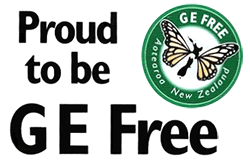AgResearch after 12 years of failure and hundreds of dead embryo�s has developed one calf, expressing less Beta - LactoGlobulin (BLG) than normal milk cows. This experiment was in the first group of GM animal applications that were approved by the Environmental Risk Management Authority (ERMA).
BLG is an essential part of milk. It lowers blood pressure by removing fatty acids that inhibit enzyme lipase�s and enhances the absorption of Vitamin A, D, E and Iron [1]. It is essential for healthy digestion, immune system function and the formation of healthy bones skin, teeth and muscle development.
BLG is destroyed by pasteurisation, however the breakdown products can cause allergies. It is removed from skim milk, cheese and butter. Existing technology that removes BGL from our milk is a highly successful business.
�This is a frightening development not a breakthrough. Researchers that stoop so low as to manipulate the Mauri of an animal causing suffering, then pretend that this is a significant breakthrough when we already have business using technology to remove BLG, are inhumane". said Claire Bleakley president of GE Free NZ
AgResearch�s experiment only details one calf, how many and what happened to the other embryos transferred? Were they born deformed, euthanased at birth or aborted by the surrogate mothers? Did the mothers die in pregnancy or birthing? Why do they have no tail? This calf is deformed and will possibly suffer from long term skeletal deformities, as BLG is an essential part of the Cows make up.
�This is a depraved macabre experiment that is the worst type of animal cruelty". said Claire Bleakley, president of GE Free NZ
�The Animal Ethics Board must consider the gratuitous nature of this experiment and shut it down immediately�.
New Zealand Government should ask is this essential to humankind and what will it do to our economic viability of our major exports? When research is used for such cruelty then exporters may choose to buy milk commodities elsewhere further worsening our farmers plight.
References:
Geoffrey W. Krissansen, 2007 Emerging Health Properties of Whey Proteins and Their Clinical Implications. J. American College of Nutrition.
Perez MD, Calvo M. (1995) Interaction of beta-lactoglobulin with retinol and fatty acids and its role as a possible biological function for this protein: a review. J Dairy Sci 78 :978� 988,1995
Chiancone E, Gattoni M. (1993) Selective removal of beta-lactoglobulin directly from cow's milk and preparation of hypoallergenic formulas: a bioaffinity method. Biotechnol Appl Biochem. 18 ( Pt 1):1-8.
Casal E.,Montilla A., Moreno FJ., Olano A, Corzo N. (2006) Use of Chitosan for selective removal of beta-lactoglobulin from whey. J Dairy Sci. 89 (5):1384-9.
ENDS:
Claire Bleakley 06 3089842 /027 348 6731
Jon Carapiet 0210507681 |


